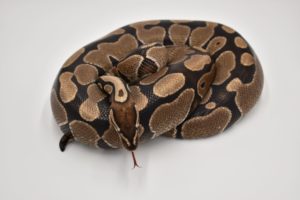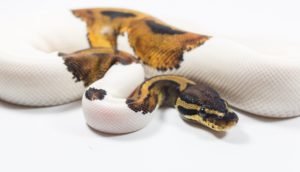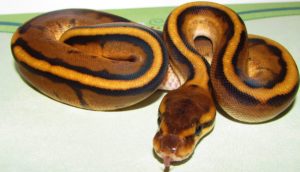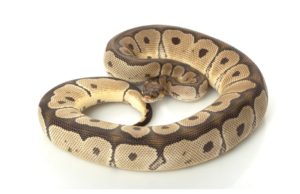Ball Pythons show high genetic variability, leading to many colour variations known as morphs. Of these, some of the most sought after are the recessive Ball Python morphs. Let’s look at those I consider to be the top 5.
What is a recessive morph?
A recessive morph is a colour or pattern variation (trait) that is expressed when a Ball Python has two recessive alleles of a gene.
Unlike dominant genes, who express their trait in the first generation, recessive genes can be inherited without their trait being expressed. It is for this reason that people often say they “skip” a generation. This makes breeding recessive Ball Python morphs more challenging, and arguably more rewarding.
Recessive traits are only expressed when both alleles of the gene responsible for a physical trait carry the recessive version. This is what is known as homozygous. So, a recessive morph is a colour or pattern variation that is expressed when a Ball Python is homozygous for a recessive trait.
If only one recessive allele is present, the other normal allele becomes dominant and masks it. It is in this scenario that a recessive mutation appears to skip a generation.
Offspring inherit one allele from each parent – so a homozygous albino animal has inherited an albino allele from both parents.
If only one parent carried the albino mutation, then it is impossible for the offspring to be visual albinos (homozygous). In this case, the offspring have one mutated allele only. We call these animals heterozygous – which is easy to remember if you remind yourself that hetero means “different”.
Heterozygous animals (generally) look like normal ones, but when you breed them together roughly 25% of their offspring will be homozygous and express the visual form of the mutation.
Why are recessive morphs important?
Recessive morphs of popular pet reptiles are highly sought after for their beauty. This makes them more valuable, and more worth the effort for breeders.
Furthermore, when you factor in the longwinded process for producing them, this means that their price depreciates more slowly.
Recessive morphs are also important for wild reptile populations. Mainly because plain coloured wild reptiles can look less attractive when compared to striking recessive morphs.
This creates a market for the morphs, and rapidly decreases the market for the “normal type”. At this point it gets tricky because recessive morphs are rare in the wild and don’t tend to do well there anyway.
The solution for this problem is of course captive breeding, and it’s no coincidence that demand for wild Ball Pythons has plummeted in Europe and the US since captive bred morphs have become available. This is an excellent example of conservation through a captive breeding market.

How have I chosen these top 5 recessive morphs?
To choose these top 5 recessive morphs I have used three criteria:
- First is popularity – do they have enduring popularity with hobbyists? To my knowledge, each of them do, and have been popular for at least ten years.
- Second is flexibility – can you breed them to other dominant or recessive morphs and create new and diverse combos? All these morphs can take on wildly different appearances when combined with other traits. This is probably what has kept their popularity going.
- Third is uniqueness – is there anything else like them? This one is important, because the more unique something is, the more surprising it is to see it. You can’t get more unique than Clown and Piebald. Though they have some related morphs, the others on this list are all unique in certain ways.
Let’s take a look…
1. Piebald Ball Python

This morph has varying degrees of white patches on an otherwise normal background. Such a simple colour combination is highly effective and makes for striking animals. Even without other genes being present, Piebald is possibly the most popular morph around.
When other genes are added, it offers surprising variations. If you add light genes such as Yellow Belly, for example, it can brighten the background or change the shape of the coloured patches. Or if you add dark genes, it can create almost black and white animals. An example of this is the Super Black Pastel Ball Python, or Panda Pied.
2. Ghost Ball Python

Ghost Ball Pythons are essentially hypomelanistic, which means they have reduced melanin. Notwithstanding, this is a slight reduction in melanin, and not as drastic as in a true albino.
This morph is popular for breeding projects because it gives the snakes a light, misty appearance. When mixed with very dark genes like GHI, it even gives the snakes an awesome ghostly, grey appearance.
Given that it can add a new aspect to any dark morph, I can’t see the popularity of the ghost mutation dropping any time soon.
3. Lavender Albino Ball Python

Like other albinos, the Lavender Albino Ball Python lacks melanin. It has a yellow and white body like other albinos, but the contrast between these two tones is much more defined. It also has darker, red eyes. With time, the white background takes on a subtle lavender tone.
When added to other recessive morphs like Clown or Pied it can create incredible animals which can be some of the most expensive in the hobby. A great example of this is the Dreamsicle Ball Python, which is a combination of Lavender Albino and Piebald.
4. Genetic Stripe Ball Python

This morph does exactly what the name says! It adds a dorsal stripe to this otherwise blotchy snake. Overall, it has limited effect on the background colouration.
A stripe is always striking, making it attractive as a morph – not just in Ball Pythons. Striped King Snakes, Milk Snakes and Boas are also highly sought after.
When combined with dominant morphs, the stripe can become more defined and contrast more with the background.
While it’s true that genetic stripe is not quite as popular as the other morphs on this list, striped snakes have been popular for a long time. Something tells me this morph will still be relatively common for many years to come.
5. Clown Ball Python

One of the most striking and unusual recessive morphs, Clown drastically changes the pattern of not just the body but also the head. In fact, the first wild caught Clown got its name because of teardrop markings below its eyes.
Overall, Clown Ball Pythons are highly variable, but almost always have a dorsal stripe and blotches along the flanks. Add in genes like Spotnose or Pastel, and you get brighter and wildly aberrant looking snakes.
As one of the most popular morphs of all, its’ only real competition for the top spot is the Piebald Ball Python.
Honourable mentions
Obviously, these aren’t the only recessive morphs available – just the ones I think are most important to the hobby.
If you’re interested in breeding Ball Pythons and creating some long-term projects, then check out the following recessive morphs. These are all gaining popularity and/or notoriety and are pretty spectacular:
- Monarch
- Amur
- Desert Ghost
- Puzzle
- Tri-stripe
- Monsoon
- Rainbow
- Paint
- Sunset
- Cryptic
In conclusion
For various reasons, I feel that these recessive morphs are worth checking out – whether you are an aspiring breeder or an individual. They are spectacular animals that can be an investment, or just a beautiful family pet.
My prediction is that each of these morphs will continue to play a major role in the hobby for years to come. The classics don’t change!
Whatever the case may be, I can assure you that buying quality, captive bred morphs is a much more responsible way to enjoy this species than buying wild-caught animals. Wild-caught imports of this species have dropped year on year for a while now – let’s aim for all our pets to be captive bred one day!
I hope you’ve enjoyed checking out my Top 5 Recessive Ball Python morphs! Did you agree with me, or should a different one have made the list? Feel free to comment or get in touch via Contact and let me know!
If, on the other, hand you’re looking for husbandry advice, check out my Ball Python Care Sheet.
If you’re looking for a baby ball python and I’ve sold out, then I recommend going to Morphmarket.com.

A really interesting and informative article.